Enjoy this unusual NAVCAM view of the comet, seen at an angle which features the larger lobe of the comet. It connects the region containing the boulder Cheops in the lower-left, up and over the comet’s neck, to the smaller lobe at lower-right.
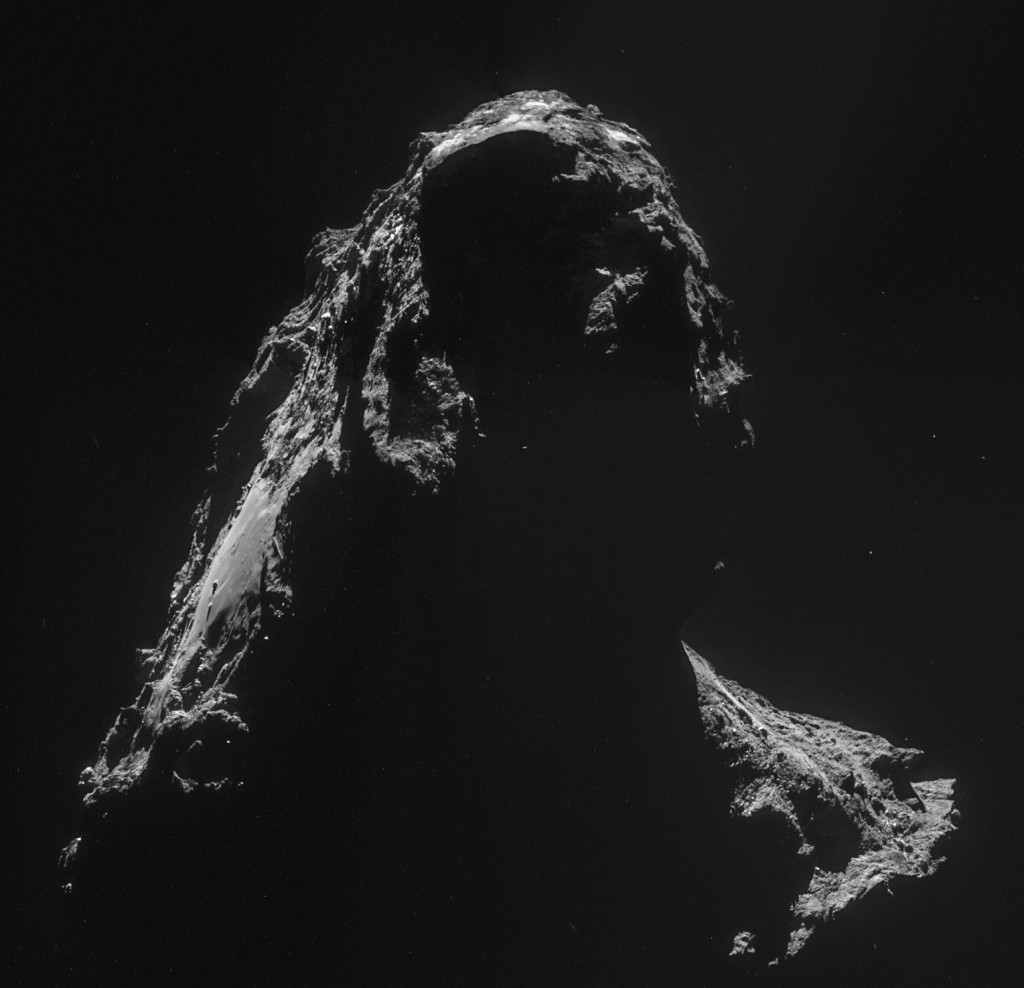
Four image NAVCAM mosaic comprising images taken on 2 November. Credits: ESA/Rosetta/NAVCAM – CC BY-SA IGO 3.0
The mosaic comprises four individual NAVCAM images taken from 33.4 km from the comet centre on 2 November. The image resolution is 2.68 m/pixel and thus each original 1024 x 1024 pixel frame measured 2.7 km across. The mosaic has been slightly rotated and cropped and covers 4.1 x 4.1 km: some contrast enhancement has been applied.
As always, rotation of the comet and movement of the spacecraft as the sequence of images was taken means that there are slight changes in illumination and perspective from one to the other, so the mosaic may not be perfectly accurate.
The four individual images are also provided below:

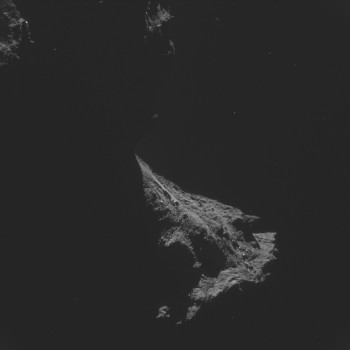
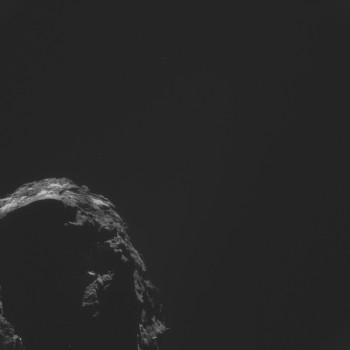
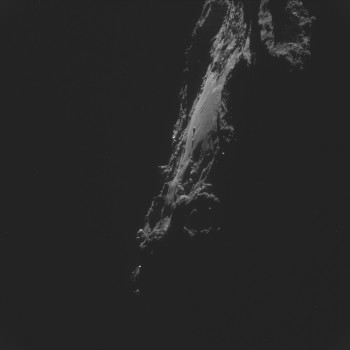
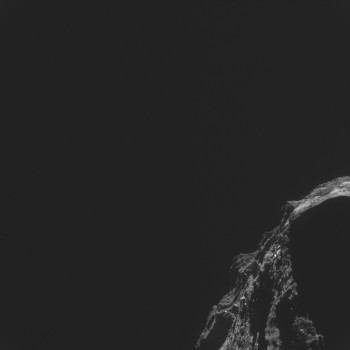








Discussion: 27 comments
OSRIS image *now*
I don’t understand why ESA does not apply *long term* communnication as they do for *long term* mission.
In nowadays we are used to instant communication that drives people interrest – Long term means today kids
are tax payer at the 10 year horizon, they’ll be EU citizen going to the pool and deciding to accept budget, including research one.
What can drive such kid interrest today? Remember most of them are not English and have a level of english close to “brian is in the kitchen”.
Amazing picture, exposing such scientific yet adventurous based chalenge is the think that can kick-off and sustain their interests.
My son for instance is browsing Mattias’ web site almost every day because Mattias is keen to expose thrilling material.
Are we or is he able to make any discovery from seen picture – prevent any educated scientist to publish proper conclusion ?
Obviously not, so why – enforcing the rule and keep secret those OSIRIS material – that is IMHO non-sense and is the open door for compirationist and the like theories.
Keep people interest with you – please – please – In six month all the interrest regarding landing site will have melt down – I hope in six month the interrest will be in discovering what the “refrozing” effet means regarding 67P – I mean for us non scientist – simple curious citizen.
Hi Emily, the article below was posted on the ESA website on 05/09/2014. Early on it seems like ESA was disclosing data that instruments on board Rosetta were obtaining, which was great. However, not a peep that I know of (please correct me if I’m wrong, or if updates are being posted other places) on what Alice has found since then about the “origin, composition and workings of comet 67P”…and that was FIVE months ago. Now, I’m all for an endless montage of really cool comet pictures and all, but we’ve all been chasing our intellectual tails on this blog on endless speculations about what Rosetta is, isn’t, was, wasn’t, could be, can’t be, should be, shouldn’t be, ad nauseam which, while quite entertaining in a sort of self-flagellating kind of way, is doubtless completely unnecessary in light of the ongoing (and most likely massive) amount of data that’s been obtained during the last 5 months by Rosetta’s compliment of 11 science instrument packages. At this point I’d concede just about anything – EU theory, white atom theory, my own right arm (or better yet, Robin’s right arm) just to hear more about the scientific data being obtained by ESA. Like the dust analysis article last week, great! Even though “the full analysis of this ‘incident’ is still pending.” Surely there are more “incidents” they can speak to. And no, I know that a few hundred amateur astro geeks debating on a blog can’t be expected to dictate such things, but the lack of information continues to be quite glaring, especially when ESA seemed willing to disclose science data and draw conclusions 5 months ago, but so little since then. Many thanks.
BEGIN ARTICLE
05/09/2014
→Alice obtains first far ultraviolet spectra of comet 67P/C-G
The Alice ultraviolet (UV) spectrograph aboard Rosetta has delivered its first scientific discoveries, making the first far ultraviolet spectra of a cometary surface.
Alice is probing the origin, composition and workings of comet 67P/Churyumov-Gerasimenko, gaining sensitive, high-resolution compositional insights that cannot be obtained by either ground-based or Earth-orbital observations.
From data collected over the last month, the Alice team discovered that the comet is unusually dark in the ultraviolet and that the comet’s surface – so far – shows no large water-ice patches. Alice is also already detecting both hydrogen and oxygen in the comet’s coma, or atmosphere.
“We’re a bit surprised at just how unreflective the comet’s surface is and how little evidence of exposed water-ice it shows,” says Dr. Alan Stern, Alice principal investigator and an associate vice president of the SwRI Space Science and Engineering Division.
“As the mission progresses, we will continue to search for surface ice patches and ultraviolet color and composition variations across the surface of the comet,” says Dr. Lori Feaga, Alice co-investigator at the University of Maryland.
Alice was developed by Southwest Research Institute and is one of three instruments funded by NASA flying aboard Rosetta.
END ARTICLE
Thanks SS. My level of frustration at the lack of data is not quite at the point of donating body parts, but I cannot disagree with your sentiments or your reasons. We are promised discussion of Rosetta’s science in Google Hangout on Friday, not any results, just another explanation of what the instruments can do and what they are measuring no doubt. I doubt very much it is going to scoop the big event on the 12th when we have been told early results and conclusions will be presented by the science teams. At this point everyone needs something new to comment and speculate on. We have already done the Universe and everything, even I am running out of drivel to spout.
To be fair, many people worked very hard for that data and they get first go at interpreting it. Their CAREERS are based upon what they learn. Be patient.
So, would they learn less or more if the packages are released now or later? Is their career really at risk? Actually if i had the opportunity to employ one of those persons struggling for a better opportunity, their work at ESA is not really going to help them, as for now nothing of essence is presented and this means the productivity level is far below my expecting. Its a lot better that those persons stay in their sand box forever. Real scientific work is not a task of keep on going for a long time and then deliver a one shot package. There are a lot of intermediate stages and it is wise to present partial results to make it possible for others to check and add their cheese as well as to sink som stupidity into the drains.
ESA once claimed that they wanted to turn fiction into science, well they are for sure having quite a hard struggle to reach this goal. This is not due to defective resources of the instrumentation, so the obvious reason is cleared by now.
It strikes me how familiar the surface of 67 looks. With a sunset behind you would mistake it for a desert on earth.
Huch, alien……
🙂
Just as I was beginning to get a grip on how gravity works on 67P, this image comes along and tells me otherwise. Looking at what we think of as the “underside” of the head lobe in Image D, we see piles of rubble “falling” up what previous views had told our minds was a vertical cliff. What we have thought of as an overhang running round the edge of the head lobe, now appears as a wide ledge at the “bottom” of a steep slope.
Earthly intuition and visual judgements seem to go out the window when it comes to this place. Imagine the confusion trying to move around on the surface with all the conflicting information coming from your eyes and the semi circular canals in your ears. An empty stomach would be a number one priority before landing.
Maybe gravity is not the only force.
Centripetal force?
That’s an easy one 🙂
Actually a good book on a comfortable couch and a tray of liquid would be my preference as the descent and landing is really slow motion. Imagine to fall with about a m/s for 7 hours, i once was in a helicopter flying at 2000 m altitude and that was extremely boring.
Here is an enhanced partial montage of the Dust Jets on 2 November 14.
It shows Polar Dust Jet activity with very high phase angle with sunlight forward scattered through the dust jet. Also visible is the general ice and dust debris of the coma. The other images of the montage series– the And B images– were not included in this montage since they showed only the diffuse glow of the coma.
Image Source: ESA/Rosetta/NAVCAM CC: BY-SA IGO 3.0
https://creativecommons.org/licenses/by-sa/3.0/igo/
–Bill
Duh. Did everything except give the location of the image:
https://univ.smugmug.com/Rosetta-Philae-Mission/Rosetta-Dust-Jets/i-P5gPNnp/0/L/ESA_Rosetta_NAVCAM_141102_C-D–montage–enh3-L.png
🙂
–Bill
Thanks a lot, Bill 🙂
Thanks for that Bill. Most of the activity still seems to be coming from the neck area, though a small prominence that could just about qualify as a jet can be seen from the head lobe. Either the material of the neck is more volatile or some additional source of energy exists in the neck region. Tidal stresses seem the most plausible, though not the only possibility.
What an incredibile achievement, when words like “usual” and “unusual” applies to photos taken by a spacecraft of a space object milions miles from earth.
Hi…just wondering about the surface…is it really hard? Are the harpoons going to stick? Also, how do you approach the object as it rotates? Without getting hit?
Its very hard on a micro scale as silicon-carbide and aluminum-oxide dust and even nano diamonds will be present. On a large scale it is as hard as a wet toast that got frozen.
Philae wants to hit the rotating comet, thats the essence of the mission and the approach is bombing it like WW2 Stuka style.
Image looks like a Lady facing East
An ‘old’ lady?
The amount of beer is not present to make this lady young..
I have a question: The bright artifacts in the picture, are some stars, are they dust on the lens, are they dead pixels, is it a combination of any and all of these?
It is not dust in the optic and there is also a possibility to detect hard radiation events. To rule out defect pixels or other static anomalies is easy done by comparing images as those errors stay put.
Mainly its bright stars and drifting obstacles like huge snowflakes the kind that was observed by a previous comet mission and had sizes up to 30 cm, also hard radiation can make its imprint.
My take on this mosaic:
https://www.flickr.com/photos/105035663@N07/15119800944/